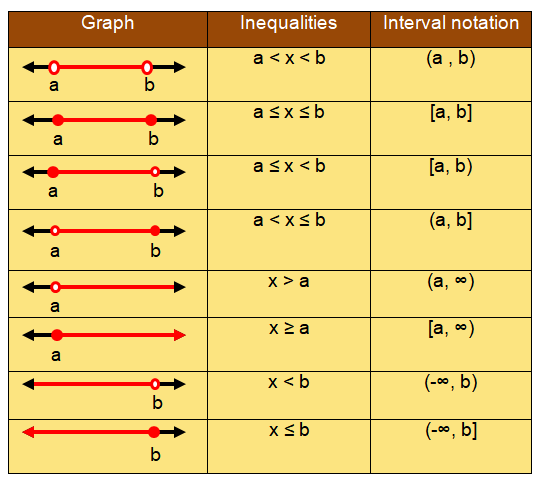WRITING INTERVAL NOTATION GIVEN A NUMBER LINE
Interval Notation :
Interval notation is a method to represent an interval on a number line. In other words, it is a way of writing subsets of the real number line.
An interval comprises the numbers lying between two specific given numbers.

Use interval notation to describe :
Problem 1 :

Solution :
By observing the number line, the possible values of x are
-2 ≤ x < 1
By expressing it as interval notation, we get
[-2, 1)
Problem 2 :

Solution :
By observing the number line, the possible values of x are
x ≤ 0 or x > 1
By expressing it as interval notation, we get
(-∞, 0] and (1, ∞)
Problem 3 :

Solution :
By observing the number line, the possible values of x are
2 ≤ x ≤ 4
By expressing it as interval notation, we get
[2, 4]
Problem 4 :

Solution :
By observing the number line, the possible values of x are
-2 < x < 1
By expressing it as interval notation, we get
(-2, 1)
Problem 5 :

Solution :
By observing the number line, the possible values of x are
x < -1 (or) x > 1
By expressing it as interval notation, we get
(-∞, -1) and (1, ∞)
Problem 6 :

Solution :
By observing the number line, the possible values of x are
0 < x ≤ 4
By expressing it as interval notation, we get
(0, 4]
Problem 7 :

Solution :
By observing the number line, the possible values of x are
x < 0 (or) x ≥ 3
By expressing it as interval notation, we get
(-∞, 0) and [3, ∞)
Problem 8 :

Solution :
By observing the number line, the possible values of x are
x ≤ -2 (or) x ≥ 2
By expressing it as interval notation, we get
(-∞, -2] and [2, ∞)
Problem 9 :

Solution :
By observing the number line, the possible values of x are
x < -2 (or) 1 < x ≤ 4
By expressing it as interval notation, we get
(-∞, -2) and (1, 4]
Problem 10 :

Solution :
By observing the number line, the possible values of x are
-2 ≤ x ≤ 1 (or) x > 3
By expressing it as interval notation, we get
[-2, -1] and (3, ∞)
Recent Articles
-
Finding Range of Values Inequality Problems
May 21, 24 08:51 PM
Finding Range of Values Inequality Problems -
Solving Two Step Inequality Word Problems
May 21, 24 08:51 AM
Solving Two Step Inequality Word Problems -
Exponential Function Context and Data Modeling
May 20, 24 10:45 PM
Exponential Function Context and Data Modeling